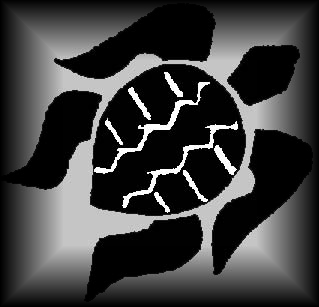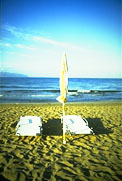
The Kefalonian Marine Turtle Project
 |
The Kefalonian Marine Turtle Project |
In 1996 a preliminary survey was carried out which aimed to find critical areas of impact to the turtle nesting zone. This was continued in 1997. A paper reviewing the findings is currently being prepared.
Introduction
Sea turtles throughout the world are subjected to many anthropogenic
threats, one of which is the development of coastal areas for the tourism industry.
This can degrade the nesting habitat of the turtle and can introduce a host
of problems (see reviews by Eckhert 1995; Groombridge 1990 and Poland et
al., 1996 for the Mediterranean; and Stringell, 1996 for Kefalonia).
Tourist activity on Mounda beach was monitored from the middle of July to the middle of August as part of a preliminary study of the tourist impact on the population of Caretta caretta nesting on Mounda beach.
The aims of the survey were:
Methods
Mounda beach was split into 8 near equal sections (Table 1.), and
these sections were surveyed every three days from the 16 July to 16 August,
1996. Each section of the beach was monitored at 10:00, 12:30, 15:00 and 17:30.
| Beach | Beach Section | Beach Markers | Length of Section (m) |
| Kaminia | A | K96 - K72 | 360 |
| Kaminia | B | K71 - K48 | 360 |
| Kaminia | C | K47 - K24 | 360 |
| Kaminia | D | K23 - K1 | 360 |
| Potamakia | E | P91 - P70 | 312 |
| Potamakia | F | P69 - P46 | 350 |
| Potamakia | G | P45 - P23 | 350 |
| Potamakia | H | P22 - P1 | 350 |
Table 1. Mounda beach sections used in the survey, 1996.
The following parameters were recorded whilst noting whether above or below the the High Water mark (as defined by the upper limit of damp sand):
No. of fixed sunbeds
No. of fixed umbrellas
Total No. of sunbeds
Total No. of independent umbrellas/shelters
No. of tourists on sunbeds only
No. of tourists using umbrellas/shelters only
No. of tourists using sunbeds & umbrellas/shelters
No. of tourists not using sunbeds or umbrellas/shelters
Total No. of tourists
Results
The spread of tourists along the beach was not uniform but concentrated
within a section of approximately 1270m. There are three vehicular accesses
onto the beach, one in the middle of section B, one in the middle of section
D and the largest one at the boundary of sections E and F.
In 1996, 41% of nests were laid between sections B and E inclusive, 26% of nests were found to lie within section 'F' alone. It is therefore section F in Potamakia beach that is most under threat from vehicular sand compaction . Around 80 sun beds and 40 umbrellas are positioned semi-permanently in close proximity to the three main vehicular accesses. It is in these areas that the majority of tourists and associated beach furniture such as shelters are located.
In 68.5% of 1996 records, the beach space above the high water line (i.e. where turtles lay their eggs) was utilised by tourists. 12/14 records show that tourists using both sun beds and umbrellas lie above the high water mark: clearly this will have a large impact on the turtle nesting zone from potential nest piercing from the sun umbrellas.
Discussion
Areas with semi-permanently fixed sunbeds pose a serious impact
to the nesting zone as tourist activity is concentrated in this area. However
the risk of actual nest penetration by umbrella shafts is relatively reduced
due to the semi-fixed positions of these sun umbrellas (Figure 1.). Adult and
hatchling emergences and their crawl paths at these areas, however, were occasionally
observed to be blocked by the beach furniture.

Figure 1. An example of the semi-fixed sunbeds and sun-umbrellas found near some of the vehicular accesses on Mounda beach (Photo. C. Morris, 1996).
Other areas of the beach provide an elevated risk to turtle nests, due to the random placement of sun-umbrellas by tourists and subsequent nest penetration. The main group of tourists that pose a threat to the turtle nesting zone are therefore those that use sun-umbrellas only. It is therefore imperative to provide informative leaflets to this group of tourists.
A great deal of conservation effort on Mounda beach should also be given to the areas around vehicular accesses. The KMTP plans to initiate, in conjunction with the local government, the erection of signs at these points.
| Notes from 1997 |
| Throughout the 1997
season, Mounda Beach was assessed for tourist usage and beach litter.
At intervals (usually 1 or 2 times per month) during the nesting and
hatching seasons, all anthropogenic litter was accounted for and subsequently
removed. Beach usage by tourists was assessed more regularly, approximately
2 to 3 times per week. For this, the beach was divided into sections
and the number of tourists and their choice of recreational activity
(e.g. sun beds, umbrellas or motor boats) noted at regular intervals
during each full day of assessment.
The litter clearance programme was increased during 1997. Approximately the same amount of material was removed in June and August, with higher amounts removed in July and September. Much of the litter was identified as having a sea-borne origin, however, terrestrial litter did increase in July and August with the height of the tourist season. The complete findings have been submitted for inclusion in the EMARC initiative looking at the fate of marine pollution.
Figure 2. A tired volunteer collecting litter. |
If readers of this page wish to contact the KMTP, they can do so via
or
T. B. Stringell tstringell@hotmail.com